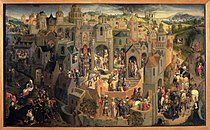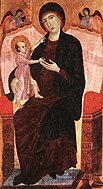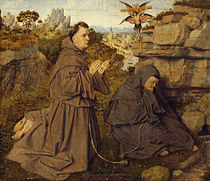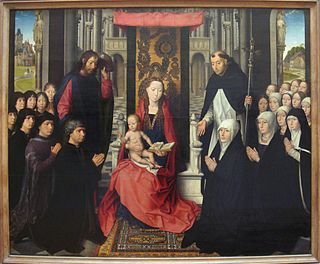
Hans Memling was a painter active in Flanders, who worked in the tradition of Early Netherlandish painting. He was born in the Middle Rhine region, and probably spent his childhood in Mainz. He moved to the Netherlands and spent time in the Brussels workshop of Rogier van der Weyden. He was subsequently made a citizen of Bruges in 1465, where he became one of the leading artists, running a large workshop, which painted religious works that often incorporated donor portraits of his wealthy patrons. Memling's patrons included burghers, clergymen, and aristocrats.

Filippino Lippi was an Italian painter working in Florence, Italy during the later years of the Early Renaissance and first few years of the High Renaissance.

Duccio di Buoninsegna was an Italian painter active in Siena, Tuscany, in the late 13th and early 14th century. He was hired throughout his life to complete many important works in government and religious buildings around Italy. Duccio is considered one of the greatest Italian painters of the Middle Ages, and is credited with creating the painting styles of Trecento and the Sienese school. He also contributed significantly to the Sienese Gothic style.

Antonello da Messina, properly Antonello di Giovanni di Antonio, but also called Antonello degli Antoni and Anglicized as Anthony of Messina, was a Sicilian painter from Messina, active during the Early Italian Renaissance. His work shows strong influences from Early Netherlandish painting, although there is no documentary evidence that he ever travelled beyond Italy. Giorgio Vasari credited him with the introduction of oil painting into Italy. Unusually for a south Italian artist of the Renaissance, his work proved influential on painters in northern Italy, especially in Venice.
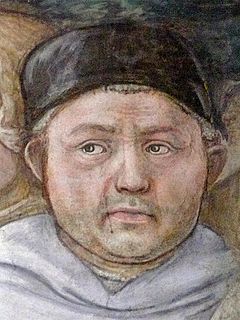
Fra'Filippo Lippi, also known as Lippo Lippi, was an Italian painter of the Quattrocento and a Carmelite Priest.

The Palazzo Pitti, in English sometimes called the Pitti Palace, is a vast, mainly Renaissance, palace in Florence, Italy. It is situated on the south side of the River Arno, a short distance from the Ponte Vecchio. The core of the present palazzo dates from 1458 and was originally the town residence of Luca Pitti, an ambitious Florentine banker.

The Doria Pamphilj Gallery is a large art collection housed in the Palazzo Doria Pamphilj in Rome, Italy, between Via del Corso and Via della Gatta. The principal entrance is on the Via del Corso. The palace façade on Via del Corso is adjacent to a church, Santa Maria in Via Lata. Like the palace, it is still privately owned by the princely Roman family Doria Pamphili. Tours of the state rooms often culminate in concerts of Baroque and Renaissance music, paying tribute to the setting and the masterpieces it contains.

Giovanni di Paolo di Grazia was an Italian painter, working primarily in Siena, becoming a prolific painter and illustrator of manuscripts, including Dante's texts. He was one of the most important painters of the 15th century Sienese School. His early works show the influence of earlier Sienese masters, but his later style was more individual, characterized by cold, harsh colours and elongated forms. His style also took on the influence of International Gothic artists such as Gentile da Fabriano. Many of his works have an unusual dreamlike atmosphere, such as the surrealistic Miracle of St. Nicholas of Tolentino painted about 1455 and now housed in the Philadelphia Museum of Art, while his last works, particularly Last Judgment, Heaven, and Hell from about 1465 and Assumption painted in 1475, both at Pinacoteca Nazionale (Siena), are grotesque treatments of their lofty subjects. Giovanni's reputation declined after his death but was revived in the 20th century.

Christ Church Picture Gallery is an art museum at Christ Church, one of the colleges of Oxford University in England. The gallery holds an important collection of about 300 Old Master paintings and nearly 2,000 drawings. It is one of the most important private collections in the United Kingdom. The greater part of the collection was bequeathed by a former member of the college, General John Guise, arriving after his death in 1765. Further gifts and bequests were made by W. T. H. Fox-Strangways, Walter Savage Landor, Sir Richard Nosworthy & C.R. Patterson.

Palazzo Bianco is one of the main buildings of the center of Genoa, Italy. It is situated at 11, via Garibaldi.
The decade of the 1480s in art involved some significant events.
The decade of the 1430s in art involved some significant events.

The Pinacoteca Nazionale is a national museum in Siena, Tuscany, Italy. Inaugurated in 1932, it houses especially late medieval and Renaissance paintings from Italian artists. It is housed in the Brigidi and Buonsignori palaces in the city's center: the former, built in the 14th century, it is traditionally identified as the Pannocchieschi family's residence. The Palazzo Bichi-Buonsignori, although built in the 15th century, has a 19th-century neo-medieval façade based on the city's Palazzo Pubblico.

The Palazzo Pretorio is a historical building in Prato, Tuscany, italy. It was the old city hall, standing in front of the current Palazzo Comunale. It now accommodates the Civic Museum of Prato, which was reopened on September 2013.

The Royal Armoury of Turin is one of the world’s most important collections of arms and armour, formed in Turin by the Savoy family. The museum is now part of the Musei Reali di Torino, the royal site that has unified the Royal Palace, the Sabauda Gallery, the Archaeological Museum, the Royal Library and the Armoury. The whole site has been included on the UNESCO World Heritage list since 1997.

The Museo d'Arte Sacra della Val d'Arbia is a small museum of religious art in Buonconvento, in the Val d'Arbia to the south of Siena, in Tuscany in central Italy. It contain a number of paintings by important artists of the Sienese School, among them Duccio di Buoninsegna, Sano di Pietro and Pietro Lorenzetti. The museum is housed in the Palazzo Ricci Socini, close to the parish church of Santi Pietro e Paolo.

The Museo Civico di Montepulciano, also known as the Museo Civico Pinacoteca Crociani, is the town or comune art gallery and museum. It is housed in the medieval Palazzo Neri Orselli, a 14th-century structure located on Via Ricci #10, corner with Via Talosa, in the center of the town of Montepulciano, in the Province of Siena, region of Tuscany, Italy. The museum was founded in 1954.

Annunciation is a 1600-1605 oil on alabaster painting by Orazio Gentileschi, later mounted on slate. Produced in Rome for an unknown private commissioner, it is now in Álvaro Saieh and Ana Guzmán's residence as part of the Alana collection in Newark, Delaware, USA.

Annunciation is a 1623 oil on canvas painting by Orazio Gentileschi, now in the Galleria Sabauda in Turin. The work was produced during the artist's stay in Genoa. Its large red curtain quotes that in Caravaggio's Death of the Virgin (Louvre), which he had seen in Rome, but the painting as a whole uses a warmer daytime light in contrast to that work's nighttime setting.







